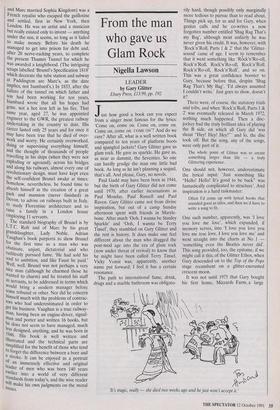Trains, boats, bridges and tunnels
J.G. Links
ISAMBARD KINGDOM BRUNEL: ENGINEERING KNIGHT ERRANT by Adrian Vaughan John Murray, £19.95, pp. 285 If you arrive at Paddington station from Bristol and make for the Bakerloo tube entrance, you will pass a bronze statue of a little man sitting in an armchair. He is holding a top-hat almost as tall as himself and is wearing a well-cut frockcoat, very different from the reach-me-downs in which he was always photographed, never without a cigar at the side of his mouth. He is Isambard Kingdom Brunel (1806-59), and he appears to be looking towards Bristol. Well he might, for he designed and saw to the building of every cutting and embankment of the railway line that has brought you here, every bridge, every coach
and locomotive (his only part failure), the accountancy system and Paddington station itself, with its marvellous glass roof, newly restored, which pre-dated the Crystal Palace. He even negotiated the purchase of almost every parcel of land on which the railway was built, the first, and often the trickiest, step in those heady days of railway construction. Characteristically, he built his railway half as wide again as any other in the country, and so it remained, isolated but faster, for another 50 years.
But if we could see where Brunel's eyes are focussed it would not be on Bristol, a mere 115 miles from London. That was the point at which the Great Western Railway stopped, but it was also where the Great Western steamship, the first to make regular voyages across the Atlantic, took over for those wishing to continue on to New York. This, too, was Brunel's creation, as were two even greater ships (which suffered accidents which proved the sound- ness of their design, even though they ruined their owners). The bridges included Maidenhead and the beautiful suspension bridge at Charing Cross, later removed to become part of Clifton Bridge, Bristol. It is hard for us, used to three kinds of `engineer' needed to mend a gas leak, to comprehend such versatility.
Brunel's roots and upbringing were apt for the development of an unusual man. His father, Marc Isambard Brunel (Isam- bard had been a family name for centuries
and Marc married Sophia Kingdom) was a French royalist who escaped the guillotine and settled, first in New York, then London. He was an artist and a musician but really existed only to invent — anything under the sun, it seems, so long as it failed to make money. Before his death he managed to get into prison for debt and, after 20 nerve-racking years, to complete the present Thames Tunnel for which he was awarded a knighthood. (The intriguing scraps labelled 'Brunel's Specification 1818' which decorate the tube station and subway at Paddington are Marc's, as the date implies, not Isambard's.) In 1833, after the failure of the tunnel on which father and son had been working for ten years, Isambard wrote that all his hopes had gone, not a hot iron left in his fire. That same year, aged 27, he was appointed engineer to the GWR, the greatest railway undertaking in the country to date. His career lasted only 25 years and for once it may have been true that he died of over- work and worry. He certainly overworked, doing or supervising everything himself, and the thought of thousands of people travelling in his ships (when they were not exploding or aground), across his bridges and along his railways, almost every one of revolutionary design, must have kept even the self-confident Brunel awake at times. Somehow, nevertheless, he found time to absorb himself in the creation of a great Park and mansion (never finished) in Devon, to advise on railways built in Italy, to study Florentine architecture and to raise a family in a London house employing 11 servants. The standard biography of Brunel is by L.T.C. Rolt and of Marc by his great granddaughter, Lady Noble. Adrian Vaughan's book purports to show Brunel for the first time as a man who was obstinate, unjust, dictatorial and who ruthlessly pursued fame. 'He had sold his sent to ambition, and like Faust he paid.' Well, well. Brunel was not perhaps a very nice man (although he charmed those he wanted to charm) and he treated his staff as servants, to be addressed in terms which Would bring a modern manager before some tribunal or other. Nor did he concern himself much with the problems of contrac- tors who had underestimated in order to get his business. Vaughan is a true railway- Than, having been an engine-driver, signal- man and porter and written 16 books, but he does not seem to have managed, much less designed, anything, and he was born in 1946. His book is well written and illustrated and the technical parts are simplified for the benefit of those who tend to forget the difference between a bore and a stroke. It can be enjoyed as a portrait 0, f an immensely effective and original leader of men who was born 140 years earlier into a world of very different standards from today's, and the wise reader will make his own judgments on the moral Issues.



























































 Previous page
Previous page